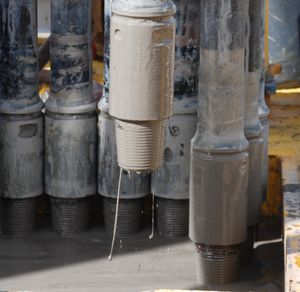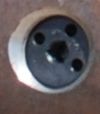Merrick Systems is providing an embedded RFID tag for oil drilling that it says is more rugged than other RFID tags, both in its ability to withstand high and low temperatures, as well as its adherence to the drill pipes as they are exposed to rotation, pressure, heat, abrasion and various chemicals in oil wells. Thus far the tag is being used by Trailblazer Drilling Corp., a division of Savannah Energy Services, and is being piloted by other unnamed companies.
Although many oil companies, oil-drilling operators and drilling-equipment providers are using RFID tags to track the multiple pipes that are joined together in long vertical strings for drilling wells, many RFID tags simply fail to perform after exposure to heat generated in the drilling process, get knocked loose or are unreadable through heavy coatings of mud. The Merrick tags, part of the Merrick Systems hardware and software solution for tracking equipment on the oil field, are about the size and shape of a U.S. quarter and embedded into the drill pipe and tubing in locations where they are less likely to be damaged. The tags that Merrick sells are encased in Victrex Peek polymers to withstand extremely high temperatures.
“Peek polymer is more robust—it can stand up to chemicals and heat. That’s the advantage for the oil industry,” says Melanie Gast, Victrex regional business manager for oil and gas. Most plastics are not chemical resistant and cannot sustain high temperatures, such as the conditions found in oil wells.
Merrick Systems is primarily an industrial information technology software provider, says Merrick president and CEO Kemal Farid. In 2005 the company saw the benefit of using RFID technology as the company entered the drilling market, and designed a software system for drill equipment and developed its own RFID tag with a 125 kHz passive chip compliant with ISO 18000-2 standard. The 125 kHz frequency provides a short read range, says Ian Binmore, Merrick’s director of drilling products, with less interference from the highly metallic environment and better able to read through chemicals that are used in the drilling process. Those chemicals include drilling fluids, acidizing treatments and polymer fluids designed to break up rock, and cements for drill hole walls, to name a few. In 2007 Merrick began offering the full RFID system, which includes HP IPAQ handheld computers with RFID readers provided by Ecom Instruments and other industrial suppliers.
Without RFID, oil drill companies have several problems. They can’t know exactly where a drill has been before, how it was used or how old it is. Sections of pipe used for making a drill assembly are stored on racks in the derrick during drilling operations or stacked on racks in pipe yards. Often to find the right piece for the drill string they are building, roughnecks need to climb around and on racks of pipe (often in windy conditions) measuring pipe with tape measures. They then write down the specifications on a piece of paper and manually enter the data into a computer later. In some cases they may use stencils to spray-paint identifying numbers on drill pipe, but that is only partially helpful. If the mark is facing the wrong way on the rack, or if it has been covered by mud or worn away, it doesn’t serve any purpose.
The equipment owners embed the Merrick tags into circular pockets machined into sides of the pipes by the owners themselves or by third-party installers, explains Binmore. These embedded RFID tags, used in conjunction with Merrick software, allows oil-field owners, drilling companies, and drilling equipment leasing companies to track equipment locations and know how it has been used by keeping an electronic record of where each piece of equipment has been and the temperature, chemicals, pressure and depth it has been exposed to, and for how long. This kind of tracking helps equipment users avoid accidents, such as a catastrophic drill string failure or breakage underground, or injuries to drilling employees.“The drilling operation is very expensive,” says Kemal Farid, Merrick president and CEO, and a string of drill pipes can cost $1 million or more. Oil wells are like cork screws, he says, with turns and twists that can damage or weaken a pipe. Temperatures within the holes can vary from 400 degrees Fahrenheit to -320 degrees when liquid nitrogen is used as an inert substance added to create a buffer inside the well. The pressure can be more than 20,000 pounds per square inch (psi). If one piece of a drill breaks, the entire string must be removed, costing many hours of delay.
With the Merrick system, drillers use a computer to design the drill string they will need. The string consists of various sizes of pipes and joints that connect those pipes, all of which are tagged. Oil drillers also use pipe for special purposes such as recording the hole angle or geological information. Merrick software enables drillers to locate the specific ID numbers on the pieces they will be using. They then use a handheld reader to identify the necessary pipes and joints by capturing their tag ID numbers. Each pipe has three RFID tags encoded with the same ID number specific to that piece of equipment. The data related to those pipes, such as where and how they have been used, is stored on a local server and can then be backed up to a server that can be hosted by Merrick or the drilling company or leaser.

After its tag is read, a pipe section or joint is connected with other pieces in a string that is then drilled into the ground. As the drill equipment operates, the drilling rig’s sensor system tracks the torque, axial tension, and downhole pressure and temperature. That data is then stored in the server using Merrick software to link it with the specific pieces of equipment involved. Companies such as Trailblazer can then access that data before reusing a pipe to know what kinds of conditions it has been exposed to in the past.
By the end of the year, Farid says, Merrick will be installing fixed readers below the drilling floor—the platform of the drilling rig where drilling operations are conducted—allowing the RFID tags to be read as the pipe sections are lowered. Farid also says there has been interest from the drilling industry in adding RFID tags to torque wrenches in order to track the amount of torque on bolts used to hold drilling equipment in place. Accidents can occur on oil rigs and at drilling operations when one or a series of bolts breaks because of errors in torque.
Currently the Merrick RFID system, says Binmore, “is hands-down the most rugged RFID tag available for drilling operations.” The tag has been tested up to 22,000 psi and can operate under exposure to 360 degrees Fahrenheit indefinitely, rather than more typical tags that can survive such heat for only short periods of time. Binmore explains Merrick accomplished that heat and pressure resistance through the design of the casing and configuration of the tag, but says that exactly how the company achieved this is proprietary information.



